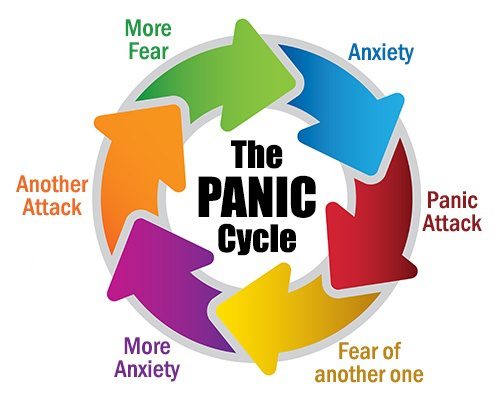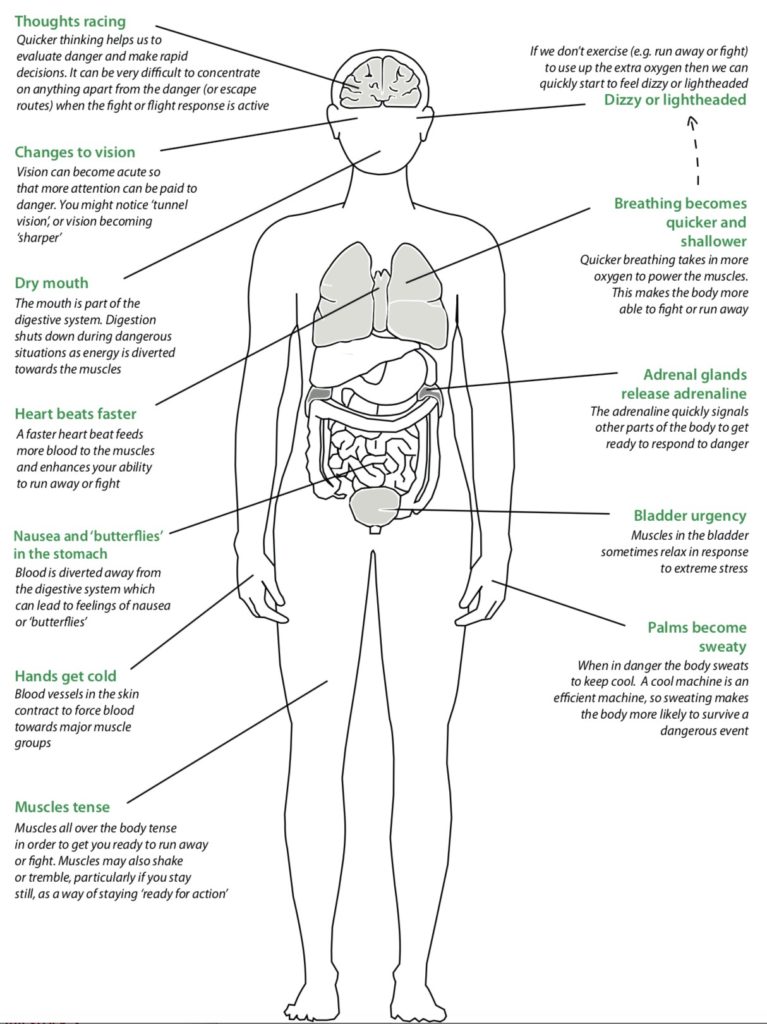A panic attack is a specific, intense exaggeration of autonomic arousal, increasing your body’s normal response to fear, stress or excitement. It’s an overwhelming build-up of physical symptoms caused by intense apprehension, fear or terror without logical or apparent cause.
Panic attacks are a learned and habitual behaviour caused by misinterpretation of the body’s response to anxiety or fear. When we are anxious or fearful our body automatically activates its fight or flight response. The fight-or-flight response, also known as the acute stress response, refers to a physiological reaction that occurs in the presence of something that is terrifying, either mentally or physically. The response is triggered by the release of hormones that prepare your body to either stay and deal with a threat or to run away to safety.
When the fight or fight response is triggered, we can experience significant disturbing symptoms which can lead to more fear and anxiety which in turn leads to even more fear and anxiety.

This build-up of anxiety is what triggers the first panic attack. Future panic attacks stem from stressful and anxious situations (such as phobias, life changes, too many stimulants like coffee or alcohol) plus the severe apprehension of having another panic attack.
The list of potential symptoms is extensive:
- Palpitations, pounding heart, or accelerated heart rate
- Sweating
- Trembling or shaking
- Sensations of shortness of breath or smothering
- Feelings of choking
- Chest pain or discomfort
- Nausea or abdominal distress
- Feeling dizzy, unsteady, light-headed, or faint
- Chills or heat sensations
- Paresthesia (numbness or tingling sensations)
- Derealisation (feelings of unreality) or depersonalisation (feeling detached from oneself)
- Fear of losing control or “going crazy”
- Fear of dying
- A sense of imminent danger, impending doom or the urge to escape.
All these symptoms stem directly from the body’s sympathetic nervous system which is activated due to the sudden release of hormones. The sympathetic nervous systems stimulate the adrenal glands triggering the release of catecholamines, which include adrenaline and noradrenaline. This results in an increase in heart rate, blood pressure, and breathing rate. After the perceived threat is gone, it takes between 20 to 60 minutes for the body to return to its pre-arousal levels.
The term ‘fight-or-flight’ represents the choices that our ancient ancestors had when faced with a danger in their environment. They could either fight or flee. In either case, the physiological and psychological response to stress prepares the body to react to the danger
The first step to overcoming panic attacks is understanding the physical and mental symptoms of our body’s automatic flight or fight response. See the below illustration.
The body's reaction to the Flight or Fight response

How is hypnotherapy used to help overcome panic attacks?
I use hypnotherapy combined with CBT (cognitive behavioural therapy) to help clients overcome panic attacks. I start by explaining the impact of the flight or fight response on the body. Once you understand the symptoms of a panic attack and why those symptoms are occurring you will be well on the road to recovery.
I then work with the client to understand the trigger or triggers, such as phobias, a stressful past experience, or apprehension about future events, and focus on changing the associated fear thinking and response. This is often all that is needed for panic attacks and their trigger to dissipate.
Call, whatsapp, Text or email me:
07305 918162
gaynor@positivehypno.com
References : https://www.verywellmind.com/what-is-the-fight-or-flight-response-2795194 https://adaa.org/understanding-anxiety/panic-disorder-agoraphobia/symptoms
